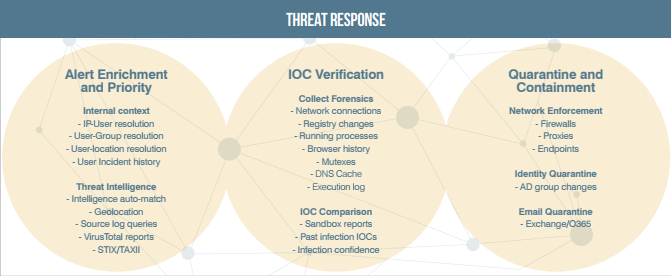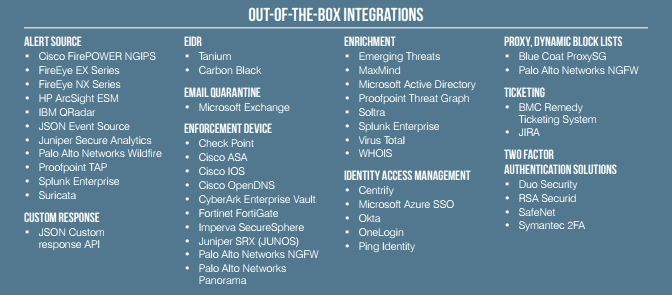
Proofpoint Threat Response
Prevent security alerts and incidents from escalating into Full-blown breaches
THREAT RESPONSE
Automated enrichment, forensics, and orchestration. Accelerate investigation, prioritize threats, and resolve incidents with less time and effort.
Sorry, this product is no longer available, please contact us for a replacement.
No defense can stop every attack. When something does get through, Proofpoint Threat Response takes the manual labor and guesswork out of incident response to help you resolve threats faster and more efficiently. Get an actionable view of threats, enrich alerts, and automate forensic collection and comparison. For verified threats, quarantine and contain users, hosts, and malicious email attachments—automatically or at the push of a button.
Proofpoint Threat Response™ is a force multiplier for security operations that orchestrates and automates incident response. The platform surrounds security alerts with rich contextual data to help security teams prioritize and execute response actions. It collects and analyzes security event context around incidents and investigations, and it collects endpoint forensics to confirm system infections to create actionable profiles of incidents. Based upon the enhanced context, it enables enforcement and quarantine actions automatically or at the push of a button leveraging existing infrastructure.
Manual Response Doesn’t Scale
At many organizations, security incident response is a slow, labor-intensive process. Time-intensive tasks turn into painful bottlenecks, including:
- Identifying high-value targets to prioritize threats
- Identifying high-value threats that may be part of larger campaigns or botnets
- Collecting and comparing endpoint forensics for signs of infection
- Managing investigations that may span multiple targets and alerts
- Negotiating between security and infrastructure with implementation time for enforcement
Repeating these tasks for every incident can overwhelm already stretched security teams, resulting in skipped steps and cut corners.
The Incident Investigation Time Penalty
Incident response investigation requires information from multiple disconnected sources where each additional data point is like a piece of a puzzle. As each piece is added, organized and analyzed, scope, severity, and priority become clearer.
Confirming that a system has been compromised usually requires a series of manual, time-consuming steps. During the investigation phase, valuable data may be stolen from infected systems while attackers may be moving laterally across the network. The quest for a complete investigation often comes at the cost of putting data at risk.

Modernize Incident Response with Threat Response
Threat Alert Source Collection and Investigation
Incident response has four main areas of focus:
- Investigate the “who, what, and where” of attacks, including targeted users, systems, and campaigns
- Verify targeted system forensics against sandbox forensic reports
- Stop the bleeding and IP loss with quarantine and containment actions
- Track incident response KPIs to ensure incidents are not missed or forgotten
These focus areas help identify which users are infected and the severity and urgency of a threat. It also helps eliminate false positives and stop the infections from spreading and data from being exfiltrated.
Who, What, and Where with Threat Response
You need to immediately determine which internal users, departments, and groups are affected. Knowing “who” means you can prioritize high-value targets such as the CFO, executive staff and finance systems over the mailroom or lower priority targets.
Besides internal context and intelligence, external factors can provide clues to suspicious IPs or domains in security alerts. These factors are pre-integrated into Threat Response with the ability to import and leverage 3rd party intelligence, including STIX/TAXII feeds, to further automate analysis.
These key external factors include:
- Domain freshness/length of registration
- Domain blacklisting
- IP and URL reputation (category and history)
- IP geolocation
- Associated campaigns
– Targeted industries for categories of customers
Infection Confirmation by Automatic IOC Verification
Threat Response collects and analyzes endpoint forensics from targeted systems to yield a rich snapshot of indicators of compromise (IOC). IOC data includes the following:
- Registry changes
- File changes
- Recent file execution log events
- Mutexes
- Network connections
- File deletion log events
- Running processes
- Browser history
- DNS Cache
This information is compared to changes reported by malware analysis tools and other systems to provide insight into the health of the client. In addition, user designed Powershell scripts can also be pushed endpoints for custom data collection or other activities.

Another key capability is checking attacked systems for past infections. When Threat Response performs an on-demand endpoint collection, it checks for IOCs not only from the current attack, but from past infections seen in your environment. This approach helps quickly and effectively verify whether past infections have spread to the system being targeted now.
Out-of-the-Box Integration with Premium Intelligence and Third-Party Tools
Threat Response automatically checks every domain and IP provided in security alerts and sandbox reports against its built-in premium intelligence feeds, including Emerging Threats Intelligence. This step removes hours of tedious work and manual one-by-one searching against intelligence services to find attacking IPs and hosts leveraging known bad sites.
Proofpoint closes the gap between threat detection and rapid response by providing our team with deep contextual data for each incident, as well as supporting a variety of network enforcement options. It’s our Incident Response analyst ‘in a box.’
Kevin Moore,
Director of Information Technology
at Fenwick & West, LLP
Threat Response can automatically or manually import threat intelligence from third parties via STIX and TAXII. This means that security teams can import and automatically match against threat feeds from various Information sharing and analysis centers (ISACs) out of the box. It supports other “bring your own intelligence” datasets via upload or by manually adding intelligence.
Using built-in VirusTotal integration, files can be checked not only once, but over time. You can see how many of 50+ anti-virus engines detect malicious signatures or properties in files dropped, downloaded or unpacked during a potential infection. Other out-of-the-box integrations include WHOIS lookups, geolocation, Active Directory connectors, and more.
Quarantine and Containment
Based-on the context and forensics collected and analyzed by the system, Threat Response presents a context rich view of the threat. This view allows analysts to take push-button response actions, identify, areas for additional investigation, or turn on automated response such as retract delivered email from users’ mailboxes, add users to low permission groups, or update blocklists of firewalls and web filters.
Incident management
A hidden risk of incident handling is the loss of context due to the amount of system consoles and browser tabs used in combination with the copy and pasting of information between those systems. In addition to the core capabilities, Threat Response includes key incident management functions that enable users and teams to investigate incidents
without losing that context while jumping from system to system. Beyond the basics of assignment and assignment tracking Threat Response also:
- Maintains a history and record for every incident and every action taken
- Tracks incident assignments at the individual and team levels
- Combines incidents into investigations
- Enables users or team members to operate at different permissions
- Triggers workflow notifications as incidents progress and change status
- Honors roles and permissions for quarantine actions, insuring only the right people can take actions at the right time
- Notifies users or teams when incidents change, such as when threat scores pass a threshold or when a quarantine action has completed
Benefits
Example benefits from using Threat Response and automating quarantine and contain actions include:
- Adding Database admins to a restricted penalty box, blocking access to sensitive information during an incident
- Clawing back delivered email to eliminate the risk of users clicking on malicious URLs or attachments again
- Blocking communication from all employees to CNC sites to break the control chain
- Limiting the ability for malware infections to spread to other systems
- Reducing redundant or duplicate analyst work by understanding larger investigations of campaigns hitting your organization
- Visualizing KPIs around slow or unprocessed incidents, incident handling throughput, and targeting of departments or permissioned groups
- Installation and setup in hours means increased security and response handling results and rapid ROI
- Automate collection of forensic data from potentially compromised systems
- Save countless hours confirming infections by comparing system PC data with detection forensics
- Reduce manual collection of data from external devices, intelligence sources and more
- Monitor incidents and processed threats with a visual interface that lets you see what’s happening at a glance
- Accelerate response decisions with integrated views of threat activity
- Quarantine and contain threats automatically or at the push of a button for fast protection
- Automatically manage users, emails, hosts, IPs, and URLs on enforcement systems throughout the attack lifecycle to free up staff for other tasks
- Get an auditable history of response actions to boost the ROI of your existing infrastructure
- Reduce dependency on custom-coded software
- Automatically create, track, and manage incident records to reduce the need for manual entry
- Stay current on malicious activity with up-to-the- minute reports of targeted users, systems, groups, and departments
Summary
Threat Response is a force multiplier for incident response. It delivers security orchestration and automation out-of-the- box by wrapping context, forensic collection and IOC comparison for infection verification, quarantine and containment capabilities, and incident management features around incidents and investigations.

Documentation:
Download the Proofpoint Threat Response Datasheet (PDF).
